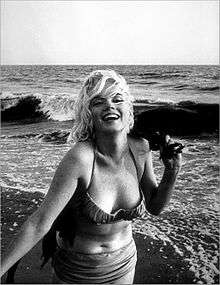Sex symbol

A sex symbol is a famous person or fictional character widely regarded to possess excessive sexual attractiveness.[2]
History
The term sex symbol was first used in the mid-1950s in relation to the popularity of certain film stars, including Marilyn Monroe, Brigitte Bardot, and Raquel Welch.[3] This concept was a reflection of the post-World War II increase of sexual and economic emancipation of women.[2]
In the 20th century, sex symbols could be male as well as female: actors such as the romantic Sessue Hayakawa and the athletic Douglas Fairbanks were popular in the 1910s and 1920s. By the 1930s, many film stars were seen as sex symbols, such as Errol Flynn, Gary Cooper and Clark Gable. In the 1940s Cary Grant was seen as still masculine but more refined. The "bad boy" image of the 1950s was epitomised by James Dean and Marlon Brando.[4]
Fictional sex symbols
With regard to fiction, Rotten Tomatoes states that the 1930s cartoon character Betty Boop is "the first and most famous sex symbol on animated screen".[5] Jessica Rabbit (voiced by Kathleen Turner) from the 1988 live-action/animation crossover film Who Framed Roger Rabbit has been described as a sex symbol as well.[6] Video games have had a few characters that are considered sex symbols; one example would be Lara Croft,[7][8][9] who has had several appearances in mainstream media. Other notable sex symbols include Rayne, the first video game character that appeared in Playboy, in its October 2004 US issue's article, "Gaming Grows Up";[10] and Nina Williams, voted "Hottest" Female Fighting Character in Guinness World Records, Gamers Edition 2008.[11]
See also
References
- ↑ "BBC World Service - Witness, The Death of Marilyn Monroe". BBC. Retrieved 30 December 2014.
- 1 2 Pam Cook, "The trouble with sex: Diana Dors and the Blonde bombshell phenomenon", In: Bruce Babinigton (ed.), British Stars and Stardom: From Alma Taylor to Sean Connery, pp. 169-171. Quote: "the sex symbol is usually defined in terms of her excessive sexuality"
- ↑ Flexner, Stuart Berg; Soukhanov, Anne H. (1997). Speaking freely: a guided tour of American English from Plymouth Rock to Silicon Valley. Oxford University Press. p. 373. ISBN 0-19-510692-X.
- ↑ Weinberg, Thomas S.; Newmahr, Staci, eds. (2014). Selves, Symbols, and Sexualities: An Interactionist Anthology: An Interactionist Anthology. Los Angeles: SAGE Publications. ISBN 1483323897.
- ↑ "Betty Boop: Boop Oop a Doop". Rottentomatoes.com. Retrieved 30 December 2014.
- ↑ "Amanda Knox Is Like Jessica Rabbit". Sky News. September 27, 2011.
- ↑ Barboza, David (19 January 1998). "Video World Is Smitten by a Gun-Toting, Tomb-Raiding Sex Symbol". The New York Times.
- ↑ "Channel 4 Top 100 Sex Symbols internet poll". Channel4.com. Retrieved 2012-05-18.
- ↑ "Boom Raider". Telegraph. London. Retrieved March 5, 2008.
- ↑ "AT's Top 10 Video Game Chicks". Actiontrip. Retrieved December 2, 2007.
- ↑ Guinness World Records, Gamers Edition 2008. 2008. p. 81. ISBN 978-1-904994-20-6.
Further reading
- Donna Leigh-Kile, Sex Symbols, Random House Inc, Aug 28, 1999, ISBN 188331951X